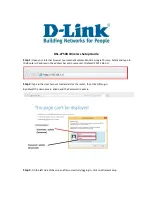
}
ISP Policy:
Select the ISP Policy (i.e., route policy database) for each Internet
connection. Thus all traffic destined to
an ISP’s servers will be forwarded through
that ISP’s connection.
IP Address:
Enter the IP address for the Device’s WAN interface, which is
provided by your ISP.
Subnet Mask:
Enter the subnet mask for the Device’s WAN interface, which is
provided by your ISP.
Gateway IP:
Enter the IP address for the default gateway, which is provided by
your ISP.
Primary DNS Server:
Enter the IP address of your ISP’s primary DNS server.
Secondary DNS Server:
Enter the IP address of your ISP’s secondary DNS
server if it is available.
4.1.3 DHCP Connection
The Dynamic Host Configuration Protocol (DHCP) is a standardized network protocol
used on IP networks for dynamically distributing network configuration parameters,
such as IP addresses for interfaces and services. With DHCP, computers request IP
addresses and networking parameters automatically from a DHCP server, reducing
the need for a network administrator or a user to configure these settings manually.
If your ISP automatically assigns an IP address, select
DHCP
. Most cable modem
subscribers use this connection type.
Figure 4-4 DHCP Connection Setup
4.1.4 Internet Connection List
When you have configured the Internet connection, you can view its status in the
















































